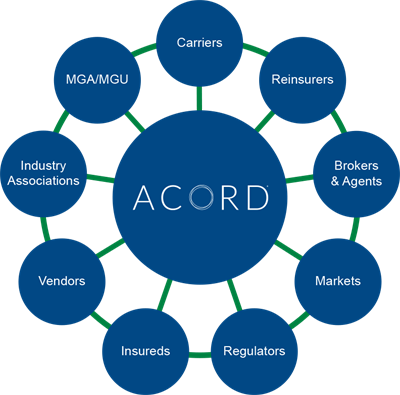ACORD’s objective is to enable the efficient and effective flow of data among all stakeholders across the insurance value chain.
All insurance transactions rely upon timely and accurate exchange of data, and with ACORD Standards, the insurance industry is able to operate optimally and provide the best experience for its consumers. Implementing ACORD Standards has been shown to improve data quality and flow, increase efficiency, and realize billion-dollar savings to the global insurance industry.

Data standards serve the same purpose as all standards, including those created for everyday household objects, such as appliances.
For example, electrical standards allow an appliance power cord, regardless of who manufactured it, to be plugged into a compatible outlet. In a similar manner, ACORD Standards allow industry stakeholders to exchange and use data for their own needs regardless of how it was created or collected. They are then able to focus on the differentiating factors that give them real competitive advantage, with the confidence that their products and processes will be compatible with the industry standard.
Data standards are particularly important to the insurance industry due to three complicating factors:
- Wide variation: Stakeholders include carriers, reinsurers, agents, brokers and third-party software vendors. Each one of these stakeholders has varying functional and technical demands as well as goals and objectives.
- Exponential data growth: The speed and magnitude of relevant data has been steadily increasing at a collective rate for the past decade.
- Industry change: Insurance faces many macroeconomic, technical and demographic changes, including increasing consumer demands, a rapidly aging workforce, and technology obsolescence.

Benefits of Insurance Data Standards
ACORD views the value of Standards through three lenses: efficiency, effectiveness, and flexibility. Once organizations adopt and implement data standards to address the challenges they are facing, they realize capability improvements across process, organization, and technology dimensions.

 Efficiency
Efficiency
- Process: Data Standards streamline operations, help reduce the amount of capacity needed for transactions, and better equip organizations to achieve straight-through processing (STP). They provide a common understanding of data, allowing the organization to collect data once and reuse it in different business areas across the enterprise.They are the first step toward a fully automated system where information is automatically transferred and shared without manual input or intervention.
- Organization: Enterprise-wide Standards allow teams to collaborate more efficiently. They will spend less time on foundational aspects of data collection, creating a more productive work environment where employees can see their direct impact on the organization, instead of being bogged down in day-to-day tasks. This increases talent retention and satisfaction.
- Technology: Data Standards give organizations the benefit of faster implementation and less costly integration. They are able to leverage off-the-shelf third party solutions to meet their business needs. They avoid creating internal proprietary solutions, which cost more to maintain.
 Effectiveness
Effectiveness
- Process: Data standards give organizations the tools to improve data accuracy and consistency, enabling the use of advanced analytics to create effective processes. They allow the organization to scale data gathering while also providing them with the option of tailoring processes to fit specific needs.
- Organization: Adopting Data Standards gives organizations the capacity to put their best people on the biggest opportunities and not the biggest problems. Organizations are more effective when their people are focusing on tasks of higher value such as customer acquisition, retention, and management rather than data entry.
- Technology: Data Standards allow organizations to increase adoption and deployment of new solutions. Using Standards gives them the tools to implement these new technologies into their respective networks and business operations.
 Flexibility
Flexibility
- Process: Data
Standards shorten the time between diagnosing changes in the
environment to adapting new processes. They enable organizations to more
easily compare themselves to other organizations, allowing them to find
and implement best-in-class practices. They can then focus on tailoring
their processes to fit their specific needs to create a competitive
advantage.
- Organization: Data Standards create a
common language for organizations to communicate with partners. It
allows each party to understand exactly what that data means and
create seamless integration.They can share new information and access
new data sources, increasing flexibility and better positioning the
organization to thrive in the evolving business landscape.
- Technology:
Standards help organizations avoid the risk of being in agreements
with partners that may be charging too much or not meeting
business needs. Instead of being unfavorably tied to custom or
proprietary solutions,the organization can migrate their data to new
solutions and change partners as their business needs and objectives
evolve.
From insurance industry leaders to vendors and researchers, the consensus is that standards are essential for improving strategic and tactical positioning of firms within the industry. As the desire to leverage data increases exponentially, the benefits of standards are becoming even more apparent. In order to survive and thrive in the emerging business environment, insurance stakeholders must be able to leverage data in a standardized manner. The implementation of ACORD Standards is a pivotal enabler.
For a more complete discussion of the benefits of Standards implementation, see our white paper on The Value of Standards.